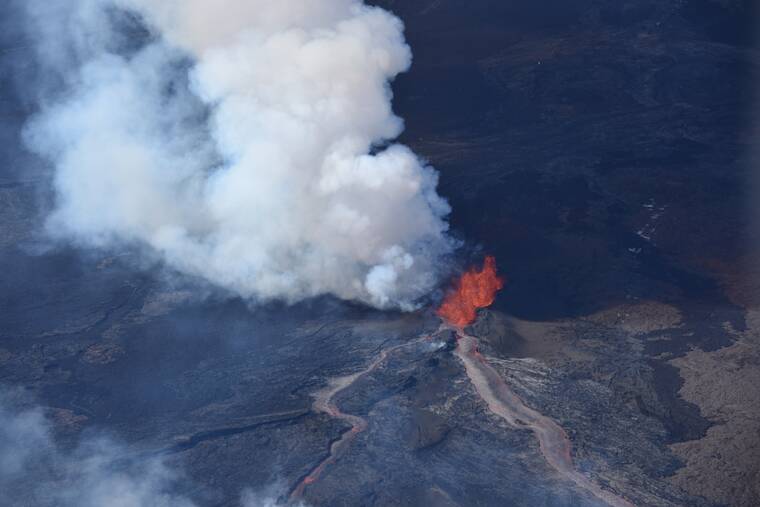Still ‘huge destructive potential’
State and county agencies continue to prepare for the impacts of a possible closure of the Daniel K. Inouye Highway.
On Friday afternoon, lava from the Mauna Loa eruption was about 2.7 miles away from the highway, also called Saddle Road, and was moving at a speed of about 45 yards per hour.
At that rate, David Phillips, deputy scientist in charge for the U.S. Geological Survey’s Hawaiian Volcano Observatory, said the lava could reach the highway within a week.
With a potentially imminent closure of the island’s primary transit corridor, and no plausible way to divert the lava, the county is preparing to redirect traffic to Highway 19 along the Hamakua Coast.
Civil Defense Administrator Talmadge Magno said Friday that Nanue Bridge, located south of Ninole on Highway 19, has reopened to both lanes of traffic following construction work.
The Hawaii Emergency Management Agency, or HI-EMA, announced Friday that it has dispatched a team to Hilo to assist with the county’s emergency response. HI-EMA Administrator Luke Meyers said the four-person team will assist Civil Defense with operations, planning and logistical challenges.
“While the lava is moving very slowly at the moment and doesn’t pose an imminent hazard to populated areas, it’s still a hazard with huge destructive potential,” Luke Meyers said in a statement. “We wouldn’t be doing our jobs if we didn’t work to define the possible impacts and recommend ways to reduce or eliminate them.”
The team will also “assemble a framework for addressing the consequences — both immediate and long-term — should the lava eventually damage or destroy part of the highway, power lines, or other crucial systems,” according to HI-EMA.
Similarly, Hawaiian Electric is assessing potential plans to maintain power across the island if Saddle Road is severed. Those plans include creating alternate driving routes to respond to outages around the island, securing additional fuel for company vehicles to account for the increase in travel time, and possibly rerouting power if lines are cut.
However, it is still not certain lava will reach the highway. Phillips said Friday it’s unclear whether the lava flow will spread more eastward or westward, but if it flows westward, it could miss the highway altogether.
Phillips also said that as the eruption progresses it becomes less likely that it will intensify. Seismic activity beneath Mauna Loa’s flank has decreased throughout the week, which he said makes it increasingly unlikely that more fissures will open in the future.
Only one of the four fissures that opened since the eruption started Sunday is significantly contributing to the lava flow anymore.
As county officials waits to see what the lava will do, thousands of people are flocking to Saddle Road each night to see the spectacle.
Mayor Mitch Roth estimated Friday that about 2,000 vehicles used the Traffic Hazard Mitigation Route the county opened Thursday night to offer a safe lava viewing area.
The Hawaii Police Department reminded drivers to use caution on the highway over the weekend, as the speed limit has been reduced to 35 mph approaching the 28.5 mile marker. Parking alongside the highway is illegal, and police will issue $1,000 citations to violators between the 16- and 31-mile markers.
As of Friday morning, 28 citations have been issued.
Email Michael Brestovansky at mbrestovansky@hawaiitribune-herald.com.


